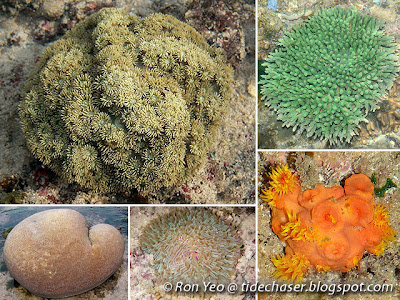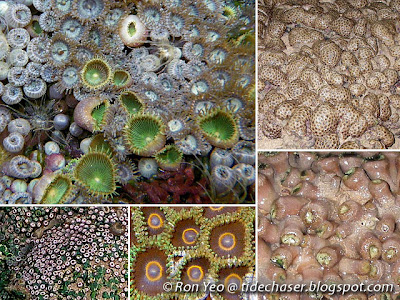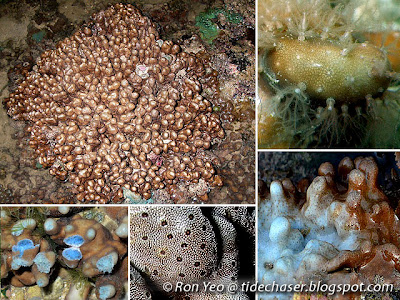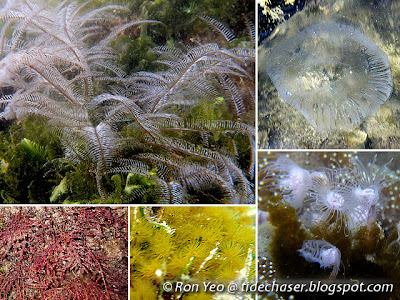Cnidarians (phylum Cnidaria) are radially symmetrical animals which possess explosive, harpoon-like cells called cnidocytes. Each cnidocyte contains a secretory organelle (cnidae), which can be a nematocyst that discharges a harpoon-like stinger carrying toxins, a ptychocyst that discharges sticky substances, or a spirocyst that discharges lasso-like threads. Hence while cnidocytes are often called "stinging cells", they can perform other functions apart from stinging. The cnidocyte has a fine, hair-like trigger on the outside which activates the discharging mechanism on contact. Many species of cnidarians can give very painful stings upon contact, and some may even be lethal. In fact, the name cnidaria comes from the greek word "knidē", which means "nettle", which is a plant with lots of hollow stinging hairs on its stem and leaves.

The body plan of a cnidarian is very simple, comprising a coelenteron (i.e. the stomach) and a mouth surrounded by feeding tentacles where most of the cnidocytes are usually located. Cnidarians do not have an anus, and hence the mouth performs both functions of ingesting food and extruding waste. They may occur in two forms – a polyp or a medusa.

A polyp houses its stomach in a elongated cylindrical body column. Solitary species usually attached themselves to the substrate with a disc-like structure (called the pedal disc) on one end (called the aboral end) of the body column. The mouth and the tentacles will be located at the opposite end (called the oral end). Colonial species usually lack the pedal disc, but instead the individual polyps living in the colony are usually connected to each other, either directly or indirectly

A medusa has an umbrella-shaped bell (which houses its stomach) with trailing tentacles. Some cnidarians alternate between polyps or medusae in various stages of their life cycles, while other only occur in one form throughout their lives.
Depending on the species, cnidarians either use their tentacles to filter tiny plankton or organic particles from the water (hence they are known as filter feeders), or they may sting and paralyse bigger prey. Many cnidarians harbour the unicellular algae, zooxanthellae, which produce food through photosynthesis and share with the host cnidarians, and in return for shelter and nutrients (waste products of the cnidarians).

Cnidarians can reproduce sexually or asexually. In sexual reproduction (see above picture), they either release their sperm and eggs into the water for external fertilisation, or brood their eggs internally and release the free-swimming larvae into the water later. In asexual reproduction, they clone themselves through budding (a new individual growing out or divided from an existing animal).
Here are some of the major groups of cnidarians that I have seen in Singapore waters.
A) CLASS ANTHOZOA
Anthozoans only have a polyp stage in their life cycles, and hence do not occur as medusae. The major groups of anthozoans I have seen in Singapore include:
1. Subclass Hexacorallia
Cnidarians from this subclass are often called hexacorals. They possess tentacles that come in multiples of six, and here are the major groups found in Singapore.
Order Actiniaria

Sea anemones (order Actiniaria) are solitary hexacorals named after a terrestrial flower, the anemone, due to their flower-like appearance. A sea anemone has a cylindrical body column, and most species have a specialised foot called a pedal disc to attach themselves to hard surfaces or to anchor themselves into soft substrates.
Order Ceriantharia

Tube anemones (order Ceriantharia) are solitary cnidarians which superficially resemble the sea anemones, but build and live in mucous tubes made of discharged nematocyst threads, mucus and bits of marine debris. They have two types of tentacles – around the mouth are shorter tentacles (a few centimetres long) which aid in transferring food particles to the mouth, and surrounding the shorter tentacles are much longer ones (can be over 10 cm long) which sting and capture small prey.
Order Corallimorpharia

Corallimorphs (order Corallimorpharia) are solitary cnidarians which superficially resemble sea anemones, but they usually have an upturned mouth (which may or may not be surrounded by tentacles or pseudotentacles), unlike the former which have inward turning ones. Their internal anatomy, however, are more similar to those of the hard corals, even though they do not secrete a hard skeleton.
Order Scleractinia

Hard corals (order Scleractinia) are hexacorals which have hard calcareous skeletons. They can be solitary or colonial. Each hard coral polyp resides in a calcareous structure called a corallite, and most species can clone themselves into huge colonies stretching many metres, comprising thousands of corallites side-by-side.
Order Zoanthidea

Zoanthids (order Zoantharia) are colonial cnidarians which resemble sea anemones clustering together in a colony, and hence they are also called colonial anemones. The polyps are connected at the base by a common fleshy tissue, and there are channels within the common tissue linking the stomachs of the individual polyps.
2) Subclass Octocorallia
Cnidarians from this subclass are often called octocorals. They possess feather-like tentacles that come in multiples of eight, and here are the major groups found in Singapore.
Order Alcyonacea

Soft corals (order Alcyonacea) are octocorals which do not secrete a hard calcareous skeleton, but instead are connected to each other by fleshy tissues, soft spreading membranes or ribbon-like horizontal branches.
Order Helioporacea

Helioporacea corals (order Helioporacea or Coenothecalia) are octocorals that live in a colony supported by a hard aragonite skeleton. In Singapore and the Indo-West Pacific region as a whole, only one species from this order has been recorded - the Blue Coral (Heliopora coerulea). The blue coral got its common name comes from its blue skeleton.
Order Pennatulacea

Sea pens (order Pennatulacea) live in colonies exhibiting quill-like appearances. They usually live on soft bottoms, such as sandy or muddy substrates, and are able to burrow into the substrates partially or completely. Unlike most other cnidarians, sea pen colonies are formed from a single large polyp called the oozooid. Secondary zooids then bud off from the sides of the oozooid to form the colony.
B) CLASS HYDROZOA

Hydrozoans (class Hydrozoa) are cnidarians which may exist either as a polyp or a medusa (more precisely a hydromedusae), or alternate between the two forms. The polyps of some species form plant-like colonies (commonly called hydroids) with chitinous skeletons, while other colonial species may build a hard calcareous skeleton instead. The medusae may be free-living (called jellyfish) or occurs as buds on the surface of the colony.
C) CLASS SCYPHOZOA

Scyphozoan jellyfish (class Scyphozoa) are cnidarians which spend the majority of their lives as free-swimming individuals, though most species have a polyp stage in their life cycles too. Unlike hydrozoan jellyfish which usually appear transparent with fine trailing tentacles, many species of scyphozoan jellyfish have coloured, translucent to opaque and thick oral arms.
References

The body plan of a cnidarian is very simple, comprising a coelenteron (i.e. the stomach) and a mouth surrounded by feeding tentacles where most of the cnidocytes are usually located. Cnidarians do not have an anus, and hence the mouth performs both functions of ingesting food and extruding waste. They may occur in two forms – a polyp or a medusa.

A polyp houses its stomach in a elongated cylindrical body column. Solitary species usually attached themselves to the substrate with a disc-like structure (called the pedal disc) on one end (called the aboral end) of the body column. The mouth and the tentacles will be located at the opposite end (called the oral end). Colonial species usually lack the pedal disc, but instead the individual polyps living in the colony are usually connected to each other, either directly or indirectly

A medusa has an umbrella-shaped bell (which houses its stomach) with trailing tentacles. Some cnidarians alternate between polyps or medusae in various stages of their life cycles, while other only occur in one form throughout their lives.
Depending on the species, cnidarians either use their tentacles to filter tiny plankton or organic particles from the water (hence they are known as filter feeders), or they may sting and paralyse bigger prey. Many cnidarians harbour the unicellular algae, zooxanthellae, which produce food through photosynthesis and share with the host cnidarians, and in return for shelter and nutrients (waste products of the cnidarians).

Cnidarians can reproduce sexually or asexually. In sexual reproduction (see above picture), they either release their sperm and eggs into the water for external fertilisation, or brood their eggs internally and release the free-swimming larvae into the water later. In asexual reproduction, they clone themselves through budding (a new individual growing out or divided from an existing animal).
Here are some of the major groups of cnidarians that I have seen in Singapore waters.
A) CLASS ANTHOZOA
Anthozoans only have a polyp stage in their life cycles, and hence do not occur as medusae. The major groups of anthozoans I have seen in Singapore include:
1. Subclass Hexacorallia
Cnidarians from this subclass are often called hexacorals. They possess tentacles that come in multiples of six, and here are the major groups found in Singapore.
Order Actiniaria

Sea anemones (order Actiniaria) are solitary hexacorals named after a terrestrial flower, the anemone, due to their flower-like appearance. A sea anemone has a cylindrical body column, and most species have a specialised foot called a pedal disc to attach themselves to hard surfaces or to anchor themselves into soft substrates.
Order Ceriantharia

Tube anemones (order Ceriantharia) are solitary cnidarians which superficially resemble the sea anemones, but build and live in mucous tubes made of discharged nematocyst threads, mucus and bits of marine debris. They have two types of tentacles – around the mouth are shorter tentacles (a few centimetres long) which aid in transferring food particles to the mouth, and surrounding the shorter tentacles are much longer ones (can be over 10 cm long) which sting and capture small prey.
Order Corallimorpharia

Corallimorphs (order Corallimorpharia) are solitary cnidarians which superficially resemble sea anemones, but they usually have an upturned mouth (which may or may not be surrounded by tentacles or pseudotentacles), unlike the former which have inward turning ones. Their internal anatomy, however, are more similar to those of the hard corals, even though they do not secrete a hard skeleton.
Order Scleractinia

Hard corals (order Scleractinia) are hexacorals which have hard calcareous skeletons. They can be solitary or colonial. Each hard coral polyp resides in a calcareous structure called a corallite, and most species can clone themselves into huge colonies stretching many metres, comprising thousands of corallites side-by-side.
Order Zoanthidea

Zoanthids (order Zoantharia) are colonial cnidarians which resemble sea anemones clustering together in a colony, and hence they are also called colonial anemones. The polyps are connected at the base by a common fleshy tissue, and there are channels within the common tissue linking the stomachs of the individual polyps.
2) Subclass Octocorallia
Cnidarians from this subclass are often called octocorals. They possess feather-like tentacles that come in multiples of eight, and here are the major groups found in Singapore.
Order Alcyonacea

Soft corals (order Alcyonacea) are octocorals which do not secrete a hard calcareous skeleton, but instead are connected to each other by fleshy tissues, soft spreading membranes or ribbon-like horizontal branches.
Order Helioporacea

Helioporacea corals (order Helioporacea or Coenothecalia) are octocorals that live in a colony supported by a hard aragonite skeleton. In Singapore and the Indo-West Pacific region as a whole, only one species from this order has been recorded - the Blue Coral (Heliopora coerulea). The blue coral got its common name comes from its blue skeleton.
Order Pennatulacea

Sea pens (order Pennatulacea) live in colonies exhibiting quill-like appearances. They usually live on soft bottoms, such as sandy or muddy substrates, and are able to burrow into the substrates partially or completely. Unlike most other cnidarians, sea pen colonies are formed from a single large polyp called the oozooid. Secondary zooids then bud off from the sides of the oozooid to form the colony.
B) CLASS HYDROZOA

Hydrozoans (class Hydrozoa) are cnidarians which may exist either as a polyp or a medusa (more precisely a hydromedusae), or alternate between the two forms. The polyps of some species form plant-like colonies (commonly called hydroids) with chitinous skeletons, while other colonial species may build a hard calcareous skeleton instead. The medusae may be free-living (called jellyfish) or occurs as buds on the surface of the colony.
C) CLASS SCYPHOZOA

Scyphozoan jellyfish (class Scyphozoa) are cnidarians which spend the majority of their lives as free-swimming individuals, though most species have a polyp stage in their life cycles too. Unlike hydrozoan jellyfish which usually appear transparent with fine trailing tentacles, many species of scyphozoan jellyfish have coloured, translucent to opaque and thick oral arms.
References
- Chou, L. M. 1998. A Guide to the Coral Reef Life of Singapore. Singapore Science Centre. 128 pp.
- Erhardt, H. and D. Knop. 2005. Corals: Indo-Pacific Field Guide. IKAN-Unterwasserachiv, Frankfurt. 305 pp.
- Ruppert, E.E. and R.D. Barnes. 1991. Invertebrate Zoology (International Edition). Saunders College Publishing. U.S.A. 1056 pp.
- World Register of Marine Species. 2012. Retrieved Jan 15, 2013, from http://www.marinespecies.org.

No comments:
Post a Comment